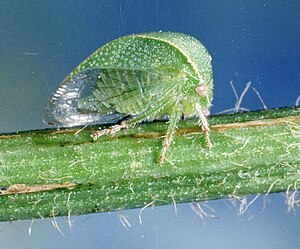Spissistilus festinus
| Spissistilus festinus | ||||||||||||
|---|---|---|---|---|---|---|---|---|---|---|---|---|

Spissistilus festinus (Say) |
||||||||||||
| Systematics | ||||||||||||
|
||||||||||||
| Scientific name | ||||||||||||
| ' Spissistilus festinus' | ||||||||||||
| ( Såy , 1830) |
Spissistilus festinus is a species of humpback chirps from the genus Spissistilus , which is widespread in northern South America as well as Central and North America. In the USA it is called "three-cornered alfalfa hopper" and is considered a pest.
distribution
S. festinus is known from Costa Rica, Brazil, Guatemala, Honduras, Mexico, Panama, Caribbean Islands, Cuba, Haiti, Puerto Rico, Canada, USA, Hawaii and Bermuda. It is considered a major pest on various crops.
description
S. festinus is a green humpback plantain with a length of approx. 6 to 7 mm. It has a pronotum that ends in a long pointed spine at the back and two smaller points at the front, reminiscent of shoulders. The pronotum has an edge on each side, which is slightly reddish in color in the males and the males are also slightly smaller than the females. Dried specimens in collections are mostly brown in color.
biology
The adult cicadas usually live individually on very different plants and suckle phloem . They often make a belt at puncture points around a plant stem. More than 20 different plant species from seven families have been reported on which S. festinus can live. The species lives particularly frequently on plants of the Fabaceae family . It can be harmful on alfalfa , soybeans and peanuts and is partially controlled.
The females usually lay their eggs in the soft tissue of the food plants by making small slits with the ovipositor. Depending on the type of plant, different numbers of eggs are placed in individual slots. The scars make it easier for the nymphs to suckle on the plants. With soybeans approx. 6 eggs are laid in each incision, with alfalfa only one or two eggs. The nymphs suckle on the plants and if they are disturbed they can release a defensive secretion. Adult cicadas usually fly away from their host plant when they are disturbed. While the nymphs can often be found in aggregations, the adult chirps are mostly solitary. In the northern parts of the distribution area S. festinus cicadas can form several generations during the summer, and in winter adult individuals survive in diapause. Females become sexually mature after only 7 to 14 days and can lay more than 200 eggs in their lifetime.
Males can attract females through their vibration signals transmitted through the host plant.
Individual evidence
- ↑ a b c C. Godoy, X. Miranda, K. Nishida: Treehoppers of tropical America . Instituto National de Biodiversidad (INBIO), 2006, ISBN 9968-927-10-4 , pp. 352 .
- ↑ LL Deitz, MS Wallace: Richness of the Nearctic Treehopper Fauna (Hemiptera: Aetalionidae and Membracidae) . In: Zootaxa . tape 3423 , 2012, p. 1-26 .
- ↑ McKamey, SH: Taxonomic catalog of the Membracoidea (exclusive of leafhoppers). In: Memoirs of the American Entomological Institute . tape 60 , 1998, pp. 1-377 .
- ↑ a b c d e f Brendan A. Beyer, Rajagopalbabu Srinivasan, Phillip M. Roberts, Mark R. Abney: Biology and Management of the Threecornered Alfalfa Hopper (Hemiptera: Membracidae) in Alfalfa, Soybean, and Peanut . In: Journal of Integrated Pest Management . tape 8 , no. 1 , January 1, 2017, doi : 10.1093 / jipm / pmx003 .
- ↑ a b c Get to Know the Threecornered Alfalfa Hopper, a (Maybe) Serious Crop Pest . In: Entomology Today . May 5, 2017 ( entomologytoday.org [accessed January 18, 2018]).
- ↑ Randy E. Hunt: Role of Vibrational Signals in Mating Behavior of Spissistilus festinus (Homoptera: Membracidae) . In: Annals of the Entomological Society of America . tape 86 , no. 3 , May 1, 1993, ISSN 0013-8746 , pp. 356-361 , doi : 10.1093 / aesa / 86.3.356 ( oup.com [accessed January 20, 2018]).